Intel Developer Forum 2008 - Live! Day 3 Keynote Coverage & The Woz
by Derek Wilson on August 21, 2008 11:00 AM EST- Posted in
- Trade Shows
Below you'll find live coverage, updated in real time, from the final day of keynotes at IDF. Refresh for the latest updates. All times are in EDT, the newest posts are at the top.

1:01 pm - Making the unthinkable possible. That's what Intel wants to do ... And that's it.
12:59 pm - While the idea was cool, they didn't really show off these things in action reassembling themselves. Which would have been nice. It was more about theory, but still cool theory.
12:58 pm - These could take 3D data from like MRIs and build the thing so it could be interacted with. On the everyday scale, things could compact and expand like cell phones. Could be tiny and fit in pocket and expand to hold at ear. or further expand to be more PDA like.
12:55 pm - They are showing some 3D catoms that are small. Little thinner than half the thickness of a dime, and these are really small. Will work on making them smaller.
12:53 pm - Built 2D mm scale catoms that can work with electrostatics.
12:53 pm - They have electromagnets that can interact at large scale, but want to move to electric fields for smaller interaction.
12:52 pm - Elements are called catoms where C comes from claytronics.
12:52 pm - It's only a couple years out they say.
12:51 pm - Taking a look at real shape shifting material demo -- Jason Campbell will talk about it.
12:51 pm - Medium formed by millions of tiny robots that can be shaped and moulded like clay but with the complexity and programmability of a computer.
12:49 pm - Last demo of the day. Clark -- advanced tech looks like magic. Notion of programmable matter. Prey reference ...
12:47 pm - Taking a little more effort, he had to concentrate more to lift a bridge into place and repair it. Kinda cool -- using the force with computers.
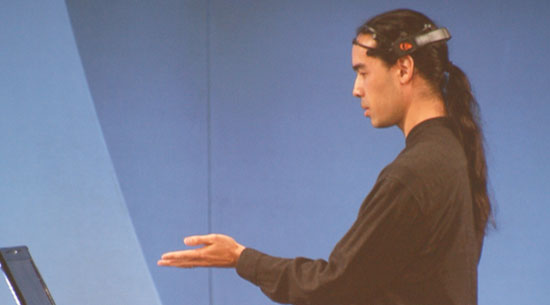
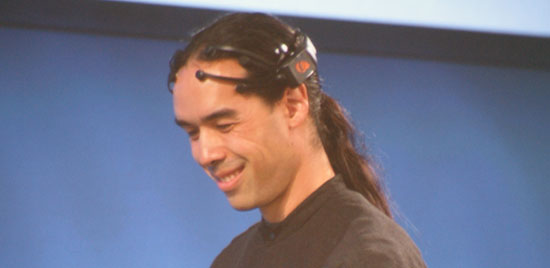
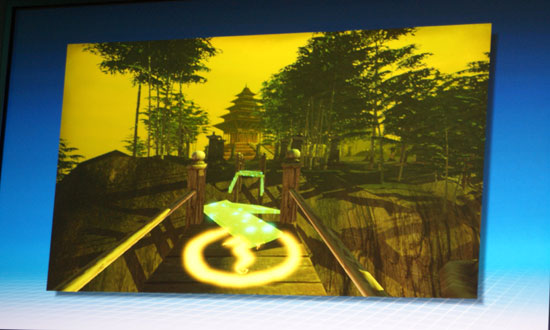
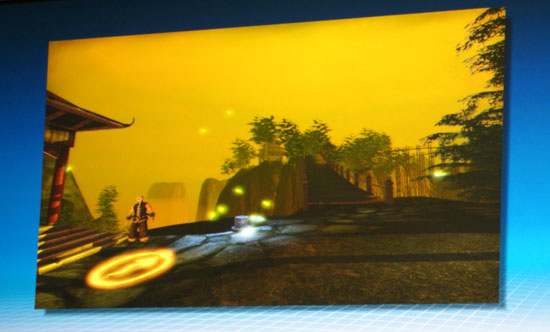
12:45 pm - Their sensor is wireless and looks like a lame hat. The demo has some little whisps that can get scared when you try and frighten them. The background can change with mood. He can lift a rock by thinking about lifting the rock.
12:45 pm - Now we have a demo with sensors on the head that detect changes through the skull.
12:44 pm - Conscious thought limits our ability to get what we want from machines. Especially with natural communication that we infer from other people, machines could benefit from total forms of communication.
12:44 pm - Tan Le is going to talk about using our brains to talk to machines.
12:42 pm - Next up is neural interfaces.
12:40 pm - They've got a robot demo that uses more sensing with electric field pretouch. It senses fields before there is a touch. It grabbed an apple and then Josh's arm. And now it gave the apple to Rattner. Much work has gone into making it safe for human interaction. (Anand's note: this demo was *hilarious*. The arm was autonomous, all it wanted to do was look for things to grab. It would ask, in a robotic voice, "where is it?" then when it found "it" it would say "got it" as it grabbed the apple, then it would immediately try and give the apple to Rattner and say "take it". The arm was super grabby, it was great.)
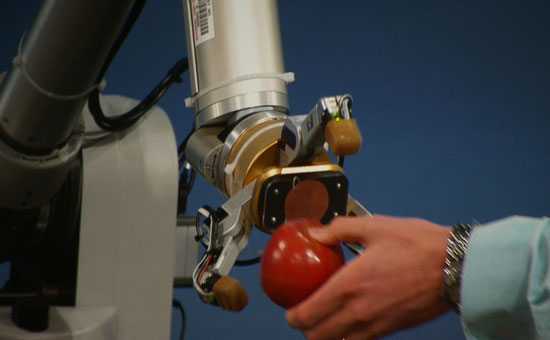
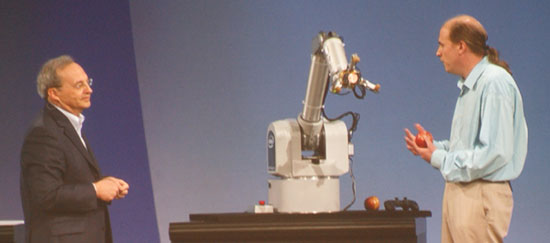
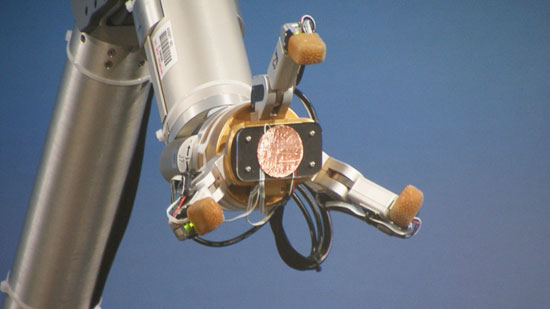
12:38 pm - Ratner is talking about more precise grasping techniques that are more difficult. Josh Smith is gonna talk about it.
12:37 pm - Robot is picking up mugs. That's its mission in life. It determines safe ways for the mug to be picked up and then ways to execute the action as well. They focused on making it move at human speeds.
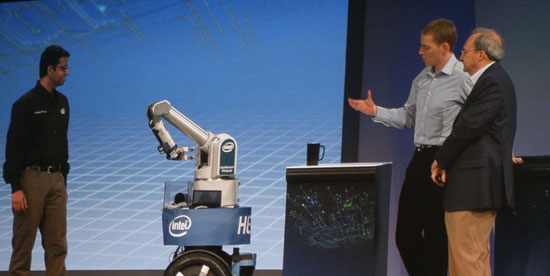
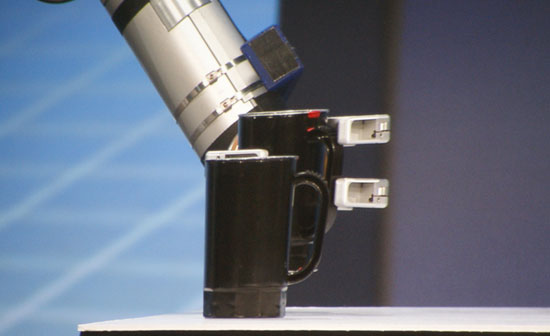
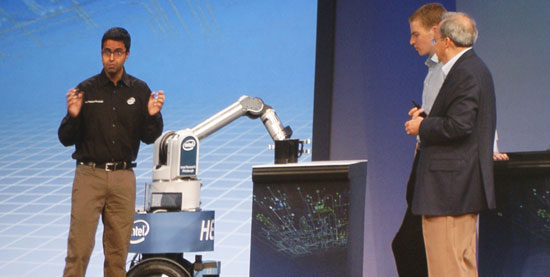
12:37 pm - They're showing off a demo with a robot called Herb.
12:35 pm - These guys are trying to build technology to make it so that we don't need static robots that don't understand their environment.
12:35 pm - Talking about the Darpa project with vehicles that can drive themselves.
12:34 pm - Robotics is up next and will play a role in going forward as well. Dave Ferguson and Siddhartha Srinivasa are talking about it.
12:33 pm - 60W at 75% efficiency at 2 feet. Form factor is going to be tough.
12:32 pm - They have some very large antenna arrays that can transmit power. Efficiency doesn't drop off for distance the same way as other solutions.
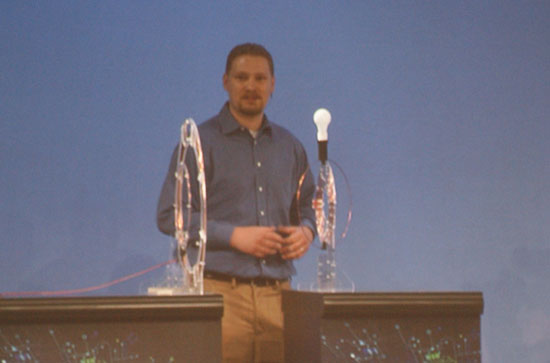
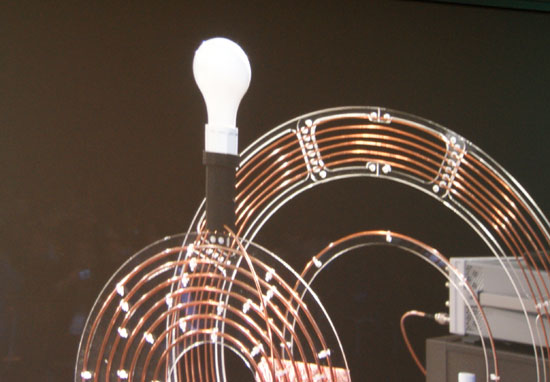
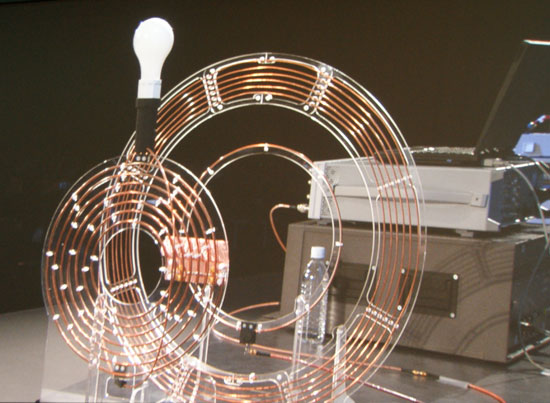
12:30 pm - Ratner is talking about wireless power transmission now. Alanson Sample is up talking about it.
12:30 pm - While government is a barrier they are looking into these things.
12:30 pm - Wireless radios fight each other, but they need to be working together. Hopping between radios and sharing power and bandwidth would help efficiently use bandwidth and power.
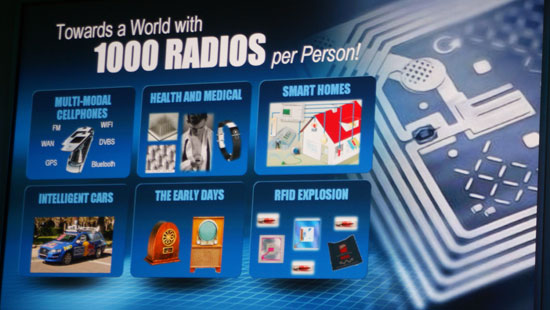
12:28 pm - Intelligent radios would analyze what bandwidth is available at what frequencies. Radios need to have sensors and processors in order to be flexible. Software definable radios can make more effective usage of bandwidth.
12:26 pm - Rabaey is talking about needing to redesign how we use spectrums. Rather than blocking off spectrums, we need to dynamically trade spectrum as needed.
12:26 pm - We need to look at shifting how we build wireless networks in today's world with today's technology.
12:25 pm - Ratner is showing of a whisp radio that scavenges power and doesn't use a battery. It wakes up when it has enough power.
12:24 pm - About 10 years from now we'll have about 1000 radios per person. Every object in the environment will have connectivity.
12:23 pm - Getting things connected is going to be hard. Jan Rabaey is on talking about massive communications.
12:22 pm - Multiple lasers can be tuned to different frequencies, and these can be send down the same pipeline. They're still working on the receive end though.
12:19 pm - They are actually demoing the hardware right now. The laser is 1mm long and we're looking at 3.2 Gbps. The modulator can run at 40 Gbps, and this runs at 8 mW of power.
12:18 pm - Intel is focusing on silicon photonics. Brian Koch is up talking about silicon lasers by binding indium phosphide transmitting light through a silicon wave guide. The new laser has mirrors integrated on the chip. This allows integration with other silicon devices.
12:17 pm - Signaling alternatives are also being explored. Especially moving from electricity to light and optics.
12:16 pm - There are lots of options in moving forward with materials engineering and we should be able to move well beyond the limits of current technology with paradigm shifts on these levels.
12:15 pm - Quantum comuting has multiple states. Which could be interesting. Mike is talking about research on spin based devices.
12:14 pm - We're talking about moveing beyond binary to multistate cells.
12:13 pm - Talking about III-V compounds (like GaAs) which can move faster than Silicon. Mike doesn't want to talk about when we're going to get away from Silicon cause Silicon is such a work horse, but they have options. Possibly combining CMOS/Silicon combined with other stuff.
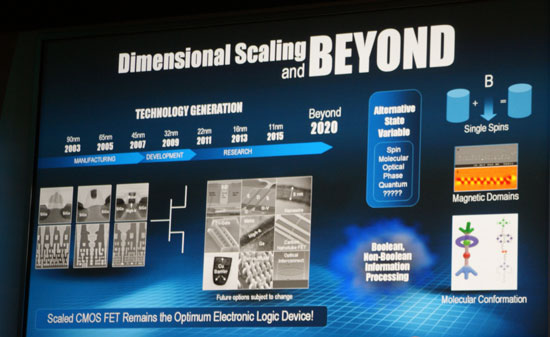
12:12 pm - The next step is to work on new materials to improve transistor performance and look at novel structures like tri-gate transistors. Tri-gate gives us higher speed, lower power, lower leakage (better transistor).
12:11 pm - Beyond 32nm and beyond CMOS, Mike Garner is going to tell us how we get past the barriers.
12:09 pm - Starting at computation, we're going to look at how this stuff is going to advance. By the way the Kurzwiel video is over and we're back to Ratner.
12:08 pm - Software is more challenging than hardware, especially when it becomes more capable than us. There's a lot of research into how to program a machine like this.
12:07 pm - It's called a singularity because like a black hole we really can't see past the event horizon.
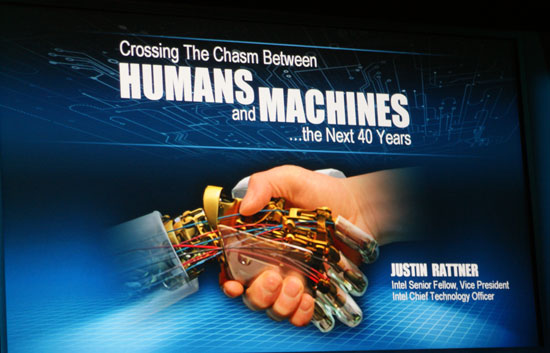
12:06 pm - Who better to talk about all this than Kurzwiel. He's going to talk about the transition where machine intelligence will surpass human intelligence. This event is called the singularity.
12:05 pm - Ratner is going to look forward to the next 40 years since this is the 40th anniversary for Intel.
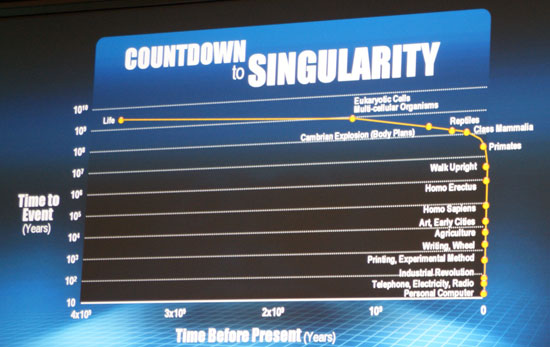
12:04 pm - Justin Ratner is up. Time for the R&D.
12:02 pm - Gordon Moore sent Woz's dad some DRAMs when they first came out cause his dad said Steve was interested. And apparently Gunn thinks it'd be a good idea for Woz to teach Moore how to ride a Segway.
12:01 pm - Teaching people is best when you start from the ground up because they learn better. And soon Steve is going to go sign his books downstairs.
12:00 pm - Woz taught kids how to impress other teachers with computers.
11:59 am - Psychology was interesting to Woz. Child development is like the development of the computer. And he paid attention to this because he really wanted to teach.
11:56 am - There was no worry about what he was going to do after college because he knew he (and he didn't finish college the first time around). Woz went back to school later to get his degree. He went under a pseudonym: Rocky Raccoon Clark. This was 10 years after he finished his 3rd year at Berkley. This was a year after a plane crash and he wanted to inspire his kids to go to school.
11:54 am - Gunn commented on the watch. There are tubes in it. 140v. Water proof. Very strange.
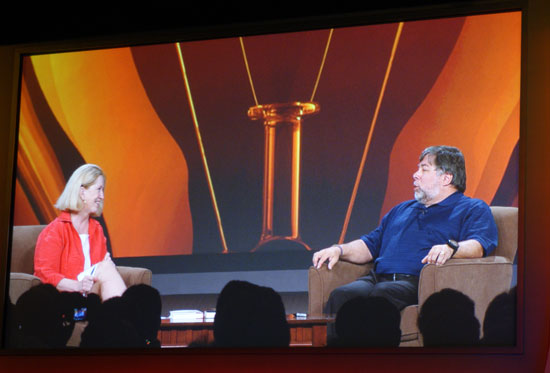
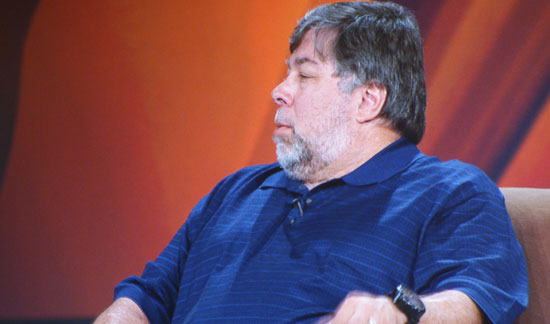
11:54 am - Are we really happier than people were 100 years ago? Woz stumbled a bit. But he thinks that technology will get us to heaven. Or something.
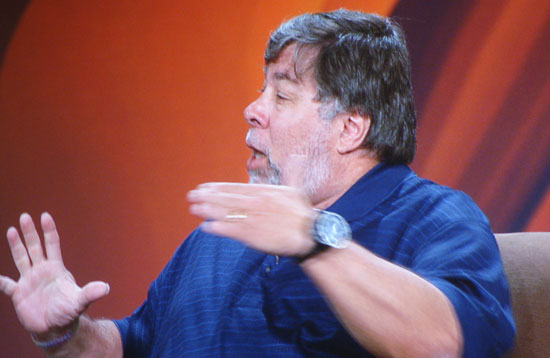
11:52 am - Woz has a huge watch. Anand just took a picture. Oh, and they're talking about the genome project for some reason. This is getting a little convoluted ...
11:50 am - Apparently you only need a 5th grade education to design or program a computer. No calculus is needed, just simple math.
11:49 am - Gunn asked Woz to talk about things that the media got wrong about him and Jobs and he kind of dodged the question :-)
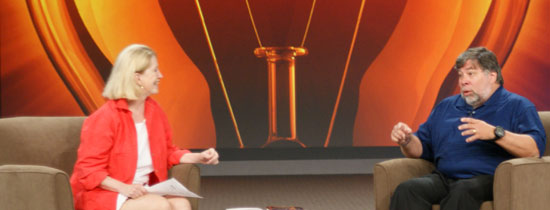
11:48 am - When Woz goes into an Apple store to buy something they give discounts to employees. When the clerk says what's your employee number he get's to say "one". The way he told the story was better and funnier ... sorry.
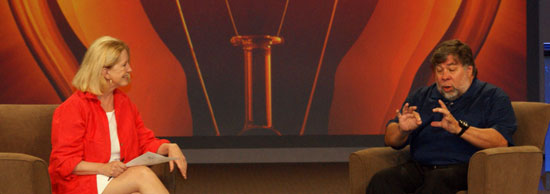
11:46 am - Running Apple wasn't interesting to Woz until someone made him realize that he didn't need to be any more than an engineer at Apple. He didn't want to do business, and didn't want to leave HP until he realized he could just keep doing what he liked doing at Apple.
11:44 am - Woz taught 5th grade for years. He said he didn't want press on the subject at the time because he didn't want press people around the kids.
11:43 am - Interestingly, the blame for the shift away from PPC to x86 is due to the focus of IBM on Cell and the Sony PS3 (and beyond). Apparently IBM didn't want to work as closely with Apple as Intel did after the shift and thus the switch happened.
11:42 am - Woz saw Jobs leaving Apple as disloyalty, and was a little wary of his return until the iPod and iPhone came along.
11:40 am - Apparently at the beginning, Jobs and Woz split Apple with at 45% each with 10% to a 3rd party who sold his shares early on. Too bad for him.
11:39 am - Woz and Jobs took things in steps and couldn't always fill orders without the money for the order.
11:37 am - And now we're talking about Steve Jobs and how their dreams were different. Woz wanted to be an engineer and Jobs wanted to be impactful and change the world, so his first instinct whenever Woz designed something was to try and sell it.
11:34 am - Apparently Intel's first microprocessor was too expensive for Woz to use in his first computer design. Even though he really liked it. Jobs was able to call them up and get Intel to send them 16 samples so they could build their first computers.
11:32 am - Woz is talking about installing some computers in Mexico with Griffin for her TV show and actually helping kids at the same time. Which is cool.
11:30 am - Woz talked about how he and Kathy Griffin tricked some people into thinking they were dating even though they weren't in order to help her get her recent TV show.
11:28 am - Apparently Steve played tricks on people when he was young. One time he built an oscillator that interfered with the TV signal and he used it trick people into doing different things to try and make their TV work.
11:25 am - Steve indicated that small groups work better than large groups, and people who are motivated to go after their own interests whether or not it is currently possible are people who can make a difference.
11:21 am - In recounting his early history he said that some times when you're short of resources it forces you to make more efficient designs. He also never saw other architectures, just manuals and he architected things for himself.
11:18 am - At 16 after finding a manual for the PDP-8 he started designing using nand gates. Later he collected manuals and started designing computers to implement the computers they described.
11:17 am - Gunn asked Woz about how he got started. Woz talked about getting started on computing by the time he was 10 years old. He was designing computers on paper long before he even realized he could do that for a living.
11:14 am - Woz said he'd rather be known as a good engineer than by anything that's happened in computers.
11:12 am - Moira Gunn is sitting down with Woz now and talking about the essence of being an engineer.
11:09 am - Let the fun begin. First up is the great and powerful Woz. Of course it looks like Eric Kim is going to re-cap and introduce him. This should be fun!










1 Comments
View All Comments
Visual - Monday, August 25, 2008 - link
so, they are building a terminator t1000?nice. i've always been sure it would become possible one day.
brain-computer interfaces are starting to be looked at seriously as well...
soon we will be living in some very interesting times... and not in the usual bad sense of the phrase, too.